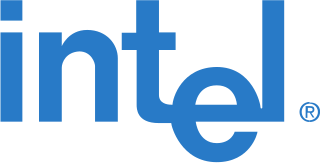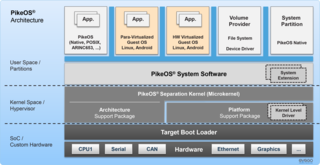
IBM PC compatible computers are similar to the original IBM PC, XT, and AT that are able to use the same software and expansion cards. Such computers were referred to as PC clones, or IBM clones. The term "IBM PC compatible" is now a historical description only, since IBM no longer sells personal computers. The designation "PC", as used in much of personal computer history, has not meant "personal computer" generally, but rather an x86 computer capable of running the same software that a contemporary IBM PC could. The term was initially in contrast to the variety of home computer systems available in the early 1980s, such as the Apple II, TRS-80, and Commodore 64. Later, the term was primarily used in contrast to Apple's Macintosh computers.
Conformance testing — an element of conformity assessment, and also known as compliance testing, or type testing — is testing or other activities that determine whether a process, product, or service complies with the requirements of a specification, technical standard, contract, or regulation. Testing is often either logical testing or physical testing. The test procedures may involve other criteria from mathematical testing or chemical testing. Beyond simple conformance, other requirements for efficiency, interoperability or compliance may apply. Conformance testing may be undertaken by the producer of the product or service being assessed, by a user, or by an accredited independent organization, which can sometimes be the author of the standard being used. When testing is accompanied by certification, the products or services may then be advertised as being certified in compliance with the referred technical standard. Manufacturers and suppliers of products and services rely on such certification including listing on the certification body's website, to assure quality to the end user and that competing suppliers are on the same level.
The Common Criteria for Information Technology Security Evaluation is an international standard for computer security certification. It is currently in version 3.1 revision 5.
Trusted Computing (TC) is a technology developed and promoted by the Trusted Computing Group. The term is taken from the field of trusted systems and has a specialized meaning that is distinct from the field of Confidential Computing. The core idea of trusted computing is to give hardware manufacturers control over what software does and does not run on a system by refusing to run unsigned software. With Trusted Computing, the computer will consistently behave in expected ways, and those behaviors will be enforced by computer hardware and software. Enforcing this behavior is achieved by loading the hardware with a unique encryption key that is inaccessible to the rest of the system and the owner.
Open Platform Communications (OPC) is a series of standards and specifications for industrial telecommunication. They are based on Object Linking and Embedding (OLE) for process control. An industrial automation task force developed the original standard in 1996 under the name OLE for Process Control. OPC specifies the communication of real-time plant data between control devices from different manufacturers.

Intel Architecture Labs (IAL) was the personal-computer system research-and-development arm of Intel during the 1990s.
The Windows Hardware Certification program is Microsoft's testing process which involves running a series of tests on third-party device drivers, and then submitting the log files from these tests to Microsoft for review. The procedure may also include Microsoft running their own tests on a wide range of equipment, such as different hardware and different Microsoft Windows editions.

Certification is the provision by an independent body of written assurance that the product, service or system in question meets specific requirements. It is the formal attestation or confirmation of certain characteristics of an object, person, or organization. This confirmation is often, but not always, provided by some form of external review, education, assessment, or audit. Accreditation is a specific organization's process of certification. According to the U.S. National Council on Measurement in Education, a certification test is a credentialing test used to determine whether individuals are knowledgeable enough in a given occupational area to be labeled "competent to practice" in that area.

Product certification or product qualification is the process of certifying that a certain product has passed performance tests and quality assurance tests, and meets qualification criteria stipulated in contracts, regulations, or specifications.
IEC 61508 is an international standard published by the International Electrotechnical Commission consisting of methods on how to apply, design, deploy and maintain automatic protection systems called safety-related systems. It is titled Functional Safety of Electrical/Electronic/Programmable Electronic Safety-related Systems.

PikeOS is a commercial, hard real-time operating system (RTOS) that offers a separation kernel based hypervisor with multiple logical partition types for many other operating systems (OS), each called a GuestOS, and applications. It enables users to build certifiable smart devices for the Internet of things (IoT) according to the high quality, safety and security standards of different industries. For safety and security critical real-time applications on controller-based systems without memory management unit (MMU) but with memory protection unit (MPU) PikeOS for MPU is available.
Mobile-device testing functions to assure the quality of mobile devices, like mobile phones, PDAs, etc. It is conducted on both hardware and software, and from the view of different procedures, the testing comprises R&D testing, factory testing and certificate testing. It involves a set of activities from monitoring and trouble shooting mobile application, content and services on real handsets. It includes verification and validation of hardware devices and software applications. Test must be conducted with multiple operating system versions, hardware configurations, device types, network capabilities, and notably with the Android operating system, with various hardware vendor interface layers.
Lynx Software Technologies, Inc. is a San Jose, California software company founded in 1988. Lynx specializes in secure virtualization and open, reliable, certifiable real-time operating systems (RTOSes). Originally known as Lynx Real-Time Systems, the company changed its name to LynuxWorks in 2000 after acquiring, and merging with, ISDCorp, an embedded systems company with a strong Linux background. In May 2014, the company changed its name to Lynx Software Technologies.

The Apple Pippin is a defunct open multimedia technology platform, designed by Apple Computer, and marketed as PiPP!N. According to Apple, Pippin was directed at the home market as "an integral part of the consumer audiovisual, stereo, and television environment."

Freeview is the brand name of the digital terrestrial television platform in Australia intended to bring all of free-to-air (FTA) broadcasters onto a consistent marketing platform, to compete against subscription television, in particular Foxtel. The strategy coincided with the expansion to 3 digital channels for each FTA network and the planned phasing out of analog television in Australia. Important services from Freeview include its free-to-air channels with an enhanced EPG across all channels. Freeview also certifies televisions, set-top boxes and personal video recorders (PVR) which meet its standards.
The CC-Link Open Automation Networks Family are a group of open industrial networks that enable devices from numerous manufacturers to communicate. They are used in a wide variety of industrial automation applications at the machine, cell and line levels.
Monitor proofing or soft-proofing is a step in the prepress printing process. It uses specialized computer software and hardware to check the accuracy of text and images used for printed products. Monitor proofing differs from conventional forms of “hard-copy” or ink-on-paper color proofing in its use of a calibrated display(s) as the output device.

NSF is a product testing, inspection, certification organization with headquarters in Ann Arbor, Michigan. NSF also offers consulting and training services worldwide.

CEBEC is a private Belgian rating label for the quality assurance of electrical appliances. Use of this label indicates that a piece of equipment conforms to European safety standards. The label is issued by SGS-CEBEC, now part of the SGS group. CEBEC has its own electrical testing laboratory located in Brussels. It is an approved laboratory for the purpose of certifications granted by SGS.
Avnu Alliance is a consortium of member companies working together to create an interoperable ecosystem of low-latency, time-synchronized, highly reliable networking devices using the IEEE open standard, Time-Sensitive Networking (TSN) and its Pro AV networking protocol, Milan. Avnu Alliance creates comprehensive certification programs to ensure interoperability of network devices. In the Professional Audio Video (AV) industry, Alliance member companies worked together to develop Milan: a standards-based, user-driven deterministic network protocol for professional media, that through certification, assures devices will work together at new levels of convenience, reliability, and functionality. Milan™ is a standards-based deterministic network protocol for real time media. Avnu Members may use the Avnu-certified or Milan-certified logo on devices that pass the conformance tests from Avnu. Not every device based on AVB or TSN is submitted for certification to the Avnu Alliance. The lack of the Avnu logo does not necessarily imply a device is incompatible with other Avnu-certified devices. The Alliance, in conjunction with other complimentary standards bodies and alliances, provides a united network foundation for use in professional AV, automotive, industrial control and consumer segments.








